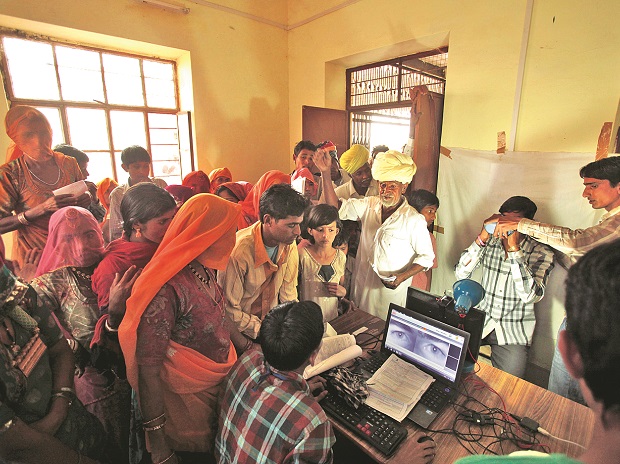The Narendra Modi government insists that the biometric data of over 1.1 billion Indians who have enrolled for Aadhaar, a 12-digit identity number, is safe. Yet, it is struggling to keep these identity numbers confidential as required by law.
On Saturday, the personal details of nearly 1.5 million pensioners were publicly displayed on the website of the Jharkhand government’s Directorate of Social Security. The details included their Aadhaar and mobile phone numbers and bank account details – a breach that could potentially expose the beneficiaries to profiling and even financial fraud. The website was taken down by the administrators on Saturday night.
On Monday, the website of the Food and Civil Supplies Department of Chandigarh was reported to have publicised Aadhaar numbers of its Public Distribution System beneficiaries. The Union Territory has nearly 490,000 such beneficiaries.
Such breaches of confidentiality have become frequent lately. On Monday, the website of the central government’s flagship Swachh Bharat Mission was found leaking Aadhaar details of its beneficiaries.
On March 29, the Unique Identification Authority of India, which manages the centralised database, blacklisted an enrolment agency after it inadvertently leaked details of former Indian cricket team captain M S Dhoni’s application to join the Aadhaar programme on Twitter. The leak and the authority’s swift action in the high-profile case were even debated in Parliament.
Security researchers, in fact, have pointed out that Aadhaar numbers and associated demographic data is even showing up through simple internet searches. On February 17, security researcher Srinivas Kodali had alerted the authorities that a website had leaked the Aadhaar demographic data of over five lakh minors.
“When I reported the government website that was leaking this data, the UIDAI did not even acknowledge the complaint,” he alleged.
He added: “Besides the one I reported, the ministry of rural development’s website was showing Aadhaar numbers and details of over one billion MNREGA workers. That was not the first and these will not be the last, because by design, you are allowing the Aadhaar number and details to be stored by anyone. You do not even need an Application Programme Interface, right now everyone can build their own database of Aadhaar numbers.”
Yet, the government has remained silent about these repeated instances of negligence leading to the exposure of ordinary citizens’ data. It has given wide publicity to its action against nine private enrolment agencies, including the one that leaked Dhoni’s application, but is yet to take action against any government agency for serious breaches of data security.
Why are the leaks serious?
Section 6 of the Aadhaar (Sharing of Information) Regulations states: the Aadhaar number of an individual shall not be published, displayed or posted publicly by any person or entity or agency.
In mandating confidentiality, the law-makers have acknowledged the sensitivity of what is designed as a single, universal, digital identity number that any registered entity, whether public or private, can use to “authenticate” an Indian resident.
Authentication can be performed either by verifying a resident’s biometrics (fingerprints or iris scans) or by matching the Aadhaar number with demographic attributes, or through a one-time password sent to a mobile number/email stored in the Central Identities Data Repository. There, the UIDAI confirms if the details — demographic or biometrics — are indeed associated with that particular Aadhaar number.
While Aadhaar regulations state that an electronic know your customer query will require biometric authentication that may make it harder to commit fraud, government authorities have negligently published large caches of demographic data associated with Aadhaar that could be misused to carry out other fraudulent authentications on behalf of an individual.
A number of mobile apps already offer commercial services to verify potential employees, tenants, etc through Aadhaar. For example, TrustID, a mobile-based platform offers to verify individuals through their Aadhaar identities, using either biometrics or by simply matching demographic details or one-time password associated with the Aadhaar number. When such platforms send a query to the UIDAI, the latter responds with a Yes/No to authenticate the individual.
Kiran Jonnalgadda, co-founder of HasGeek, a community for software developers in Bengaluru, said such fraud would be “not be easy to detect and fix, as it is an electronic verification over a mobile app with no tell-tale physical signs.”
“And once an individual faces fraud, it is not clear how their Aadhaar numbers will be replaced with new ones as these are linked to third party databases that expect the number to be unique to an individual. What happens when the same individual shows up in a third party databases with both old and new numbers?,” he added. “The only solution would be is if these were revocable hardware tokens, such as chip and PIN credit or debit cards, or SIM cards, where having the physical card matters, but which can be replaced.”
There are also concerns with the government having made Aadhaar mandatory for a wide range of schemes. Increasingly, an Aadhaar card is being considered sufficient as a form of identification by authorities.
In a blog post, writer Senthil has pointed out that the UIDAI does not include holograms or physical signatures or any other security information in the Aadhaar cards that are sent to applicants?. These are just colour printouts that are easy to replicate. The availability of Aadhaar numbers and demographic data in the public domain could heighten the risk of the use of fake Aadhaar cards.
On its part, the UIDAI allows individuals to receive alerts on mobile or email each time their Aadhaar number is authenticated, but it is not mandatory to register for it.
More seriously, under the law, the UIDAI is not under any legal obligation to inform Aadhaar users when a crime related to their personal data occurs. And the victims cannot approach a court directly because under Section 47 (1) of the Aadhaar Act, the UIDAI has the exclusive power to make complaints in case of any violation or breach of privacy.
In arrangement with Scroll.in
